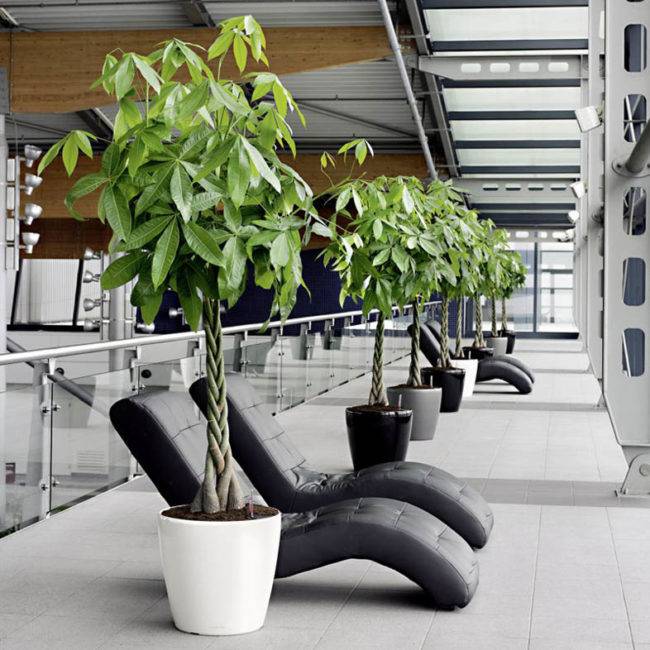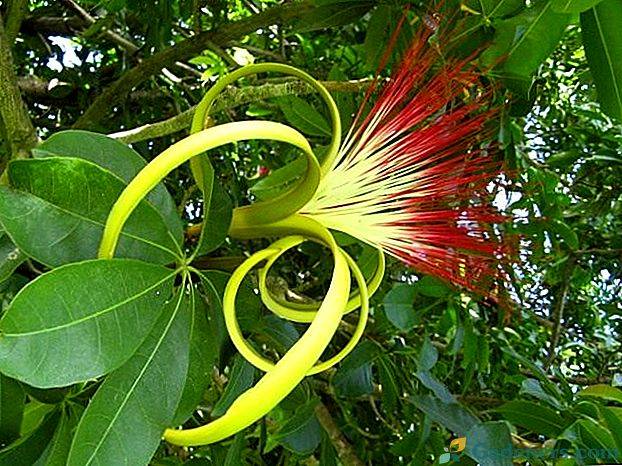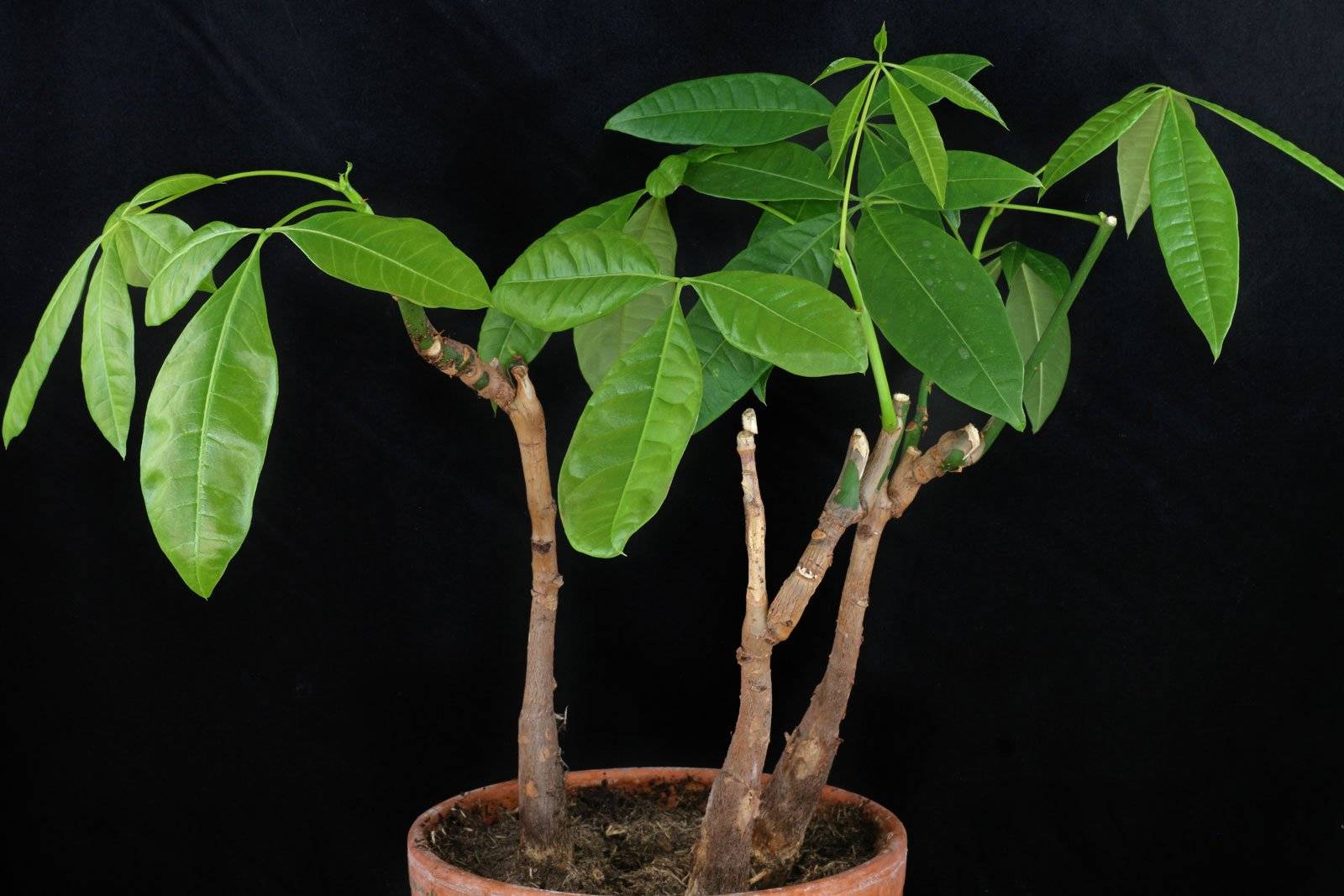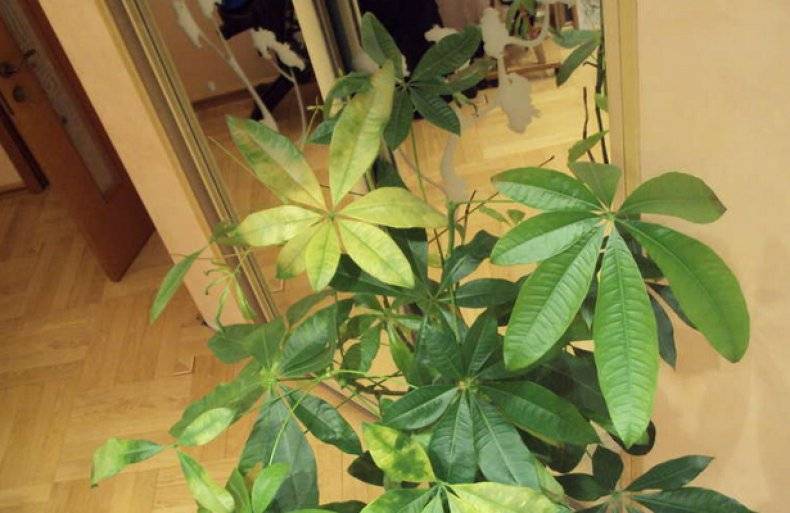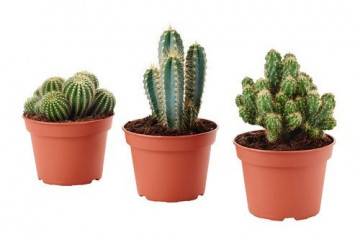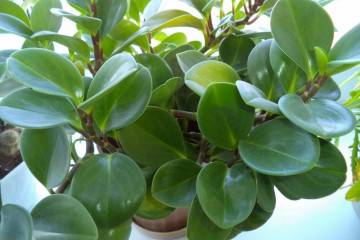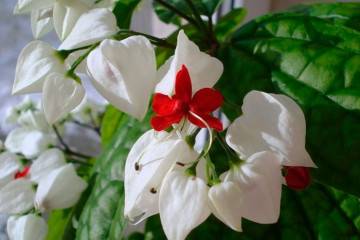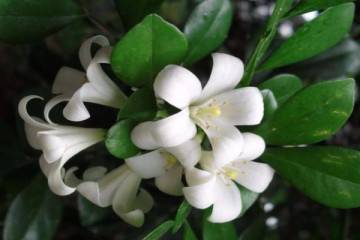Pakhira: home care and examples of popular varieties
Content:
In flower shops, pakhira is usually sold in the form of a tree with braided trunks. This plant is not only decorative and deciduous, but also decorative flowering. If the plantation is provided with the necessary conditions, it will delight its owner with a spectacular look for a long time. The following is information on growing a crop at home.
Main types
Several types of culture are suitable for indoor keeping.
Aquatica
The second name is water pakhira. This type of culture is the most popular among flower growers. At the base of the trunk there is a thickening in which moisture is stored. Leaves are finger-green leathery. Pakhira aquatic blooms from early summer to mid-autumn with beautiful paniculate inflorescences. During flowering, the plant emits a vanilla aroma. Caring for pakhira aquatica is simple.
Round-leaved
The pakhira got its name for its round sheets. The peculiarity of the species is that the shoots of plants are creeping. In the interior, it looks beautiful next to plantations with upright branches.
Silvery
According to its characteristics, the plant is similar to pakhira aquatic. The difference lies in the fact that there are silvery stripes on the green leaves, which give the leaf plates an openwork appearance. Due to this quality, silver pakhira is distinguished by its beauty and originality.
Home care
With a correctly chosen place of maintenance and the necessary agrotechnical work by a florist, the planting can grow up to 2.5-3 m.
Temperature
Pakhira is a southern plant, so at home it needs to be kept warm. The optimum air temperature in the room where the plant is installed should vary between 22-26 ° C.
The planting is placed in such a place that cold air does not get onto it when the room is ventilated. Installing a plant near radiators will also have a negative impact. Pakhira does not tolerate temperature changes, therefore, it can be transferred to the terrace only during the period when the air warms up about the same day and night.
Watering
Pakhira is watered abundantly, but not often, since its thick trunks are capable of storing moisture. It is necessary to ensure that the soil layer has time to dry out before the next watering, otherwise the root system may be affected by putrefactive microorganisms. You need to pour water not in the center, but along the edges of the pot. Excess fluid after 15-20 minutes. after watering, pour out from the pan.
The soil
For pakhira, the soil is easy to prepare yourself. If this is not possible, a substrate for palm trees is purchased at a flower shop. It should be loose, water-permeable. The soil can be prepared independently from the following components:
- leafy land;
- sod land;
- peat;
- sand.
Charcoal is added to the substrate to suppress pathogens and vermiculite for friability.
Humidity
High humidity pakhira is not required. But in the summer, several times a week, the plant can be sprayed with water from a spray bottle. Thus, dust will be removed from the leaves that interferes with the development of the plantation. In this case, you should try not to wet the trunk, which is prone to decay.
Illumination
The illumination of the room is of great importance for the decorativeness of the leaves. For pakhira, they choose a bright place without hitting the crown of the direct rays of the sun. On a hot afternoon, windows need to be shaded. Otherwise, the leaves may burn and lose their decorative appearance.
The bushes will feel comfortable on the windowsills of the eastern or western orientation. When kept on the north side of the room, the trunks can be pulled out from lack of light.
Pruning
Pachira Aquatica grows rapidly, but the lower part of the trunks becomes exposed. To get rid of this shortcoming, the plant can be pruned periodically. Some time after the procedure, new shoots will begin to grow, the crown of the tree will become denser.
To prevent infection of the plant with various diseases, pruning of pachyra is done with a sharp, disinfected tool.
Transplant features
After purchase, the plant is installed for several days in a shaded place to get used to the new conditions of detention. Then the transplant is performed as follows:
- They pick up a pot slightly larger than the one in which the flower grew. A small layer of expanded clay or small stones is laid out on the bottom.
- A layer of substrate is poured on top of the drainage.
- The pakhira is carefully shaken out of the pot, together with the old layer of soil, planted in a new container. The space between the container and the earthen lump is covered with a substrate.
- The pakhira is watered and placed in a shaded place.
You can transplant a plantation without a clod of old earth. To do this, shake it off, examine the root system, wash it with water. The roots can be trimmed slightly if necessary. Then the plant is placed in the center of the pot, covered with substrate.
Reproduction methods
Pakhira can be propagated at home by cuttings and the seed method.
Cuttings
The procedure is carried out at the end of summer: by this time the cuttings will become lignified and ready for reproduction. They are cut off along with the heel, then the following actions are performed:
- The cuttings are kept for 10-12 hours in a growth enhancer solution, planted in a box filled with light, fertile soil.
- The container is covered with foil to create a greenhouse environment.
- Install in a warm place.
Every day, the film is removed, condensate is removed from it and from the walls of the container. After about 2 weeks, roots will appear on the shoots. When the cuttings begin to grow, they are transplanted into separate pots.
Another possible option to propagate pakhira is by rooting in water. To prevent the twigs from rotting, the liquid in the container is changed every day. When the root system appears, the cuttings are planted in pots. This option is good because you can trace the appearance and growth of roots through the walls of a transparent vessel.
Seeds
The most suitable season for seed propagation of the pakhira tree is spring. Seed material must be fresh, collected no more than six months before the procedure. Sowing is done as follows:
- Drainage is laid out at the bottom of the box, then light, fertile soil is poured.
- In the substrate, grooves are made to a depth of 0.5 cm, into which the seeds are poured.
- They are watered, covered with earth.
The box is covered with plastic wrap to create favorable conditions for seed germination.You need to look after the seedlings: ventilate, water, loosen the ground. After 3-4 weeks, the seeds will germinate, after which the film is removed. Saplings dive into separate small containers. When young plants develop, they are planted in pots, which are set in a bright place.
Possible growing problems
If pakhira is provided with the necessary conditions, it is rarely exposed to diseases and pests. Problems can arise with incorrect content. What to do if pakhira leaves turn yellow and fall off?
Plant decay
The problem can happen when there is an excess of moisture at the base of the roots. To stop further decay, the damaged parts of the pakhira need to be cut off, sprayed with a fungicide solution, covered with garden varnish, and transplanted into new soil. In the future, you need to avoid excessive watering, especially in the cold season.
The leaves are curled
The problem can form with a sharp temperature drop. So that the leaves do not lose color, do not curl or fall off, a constant air temperature must be set for the culture. Another possible reason is that the air in the room is too dry, and the plant was attacked by a spider mite. You can get rid of it by flushing it under running water. If there is a lot of pest, pakhira palm is sprayed with insecticide.
Spots on foliage
Light spots are caused by sunburn. To prevent them, the plants are installed on a light windowsill, which does not get the scorching rays of the sun on a hot afternoon. If brown spots appear on the edges of the leaves, this may indicate low night temperatures, insufficient watering, and drafts.
Pakhira is a flower, a decorative planting for home decoration. All parts of the plant look spectacular: foliage, inflorescences, trunks intertwined in a pigtail. With good care, the flower grows quickly, blooms beautifully, multiplies easily. If pakhira is provided with the necessary conditions, it can delight others with its decorative appearance for many years.
